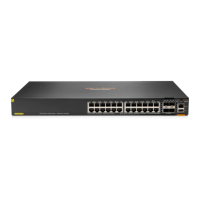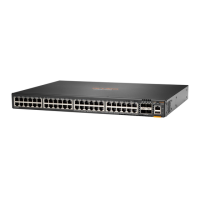102
Protocols and standards
MSTP is documented in the following protocols and standards:
• IEEE 802.1d, Media Access Control (MAC) Bridges
• IEEE 802.1w, Part 3: Media Access Control (MAC) Bridges—Amendment 2: Rapid
Reconfiguration
• IEEE 802.1s, Virtual Bridged Local Area Networks—Amendment 3: Multiple Spanning Trees
• IEEE 802.1Q-REV/D1.3, Media Access Control (MAC) Bridges and Virtual Bridged Local Area
Networks —Clause 13: Spanning tree Protocols
Spanning tree configuration task lists
Before configuring a spanning tree, complete the following tasks:
• Determine the spanning tree protocol to be used (STP, RSTP, PVST, or MSTP).
• Plan the device roles (the root bridge or leaf node).
When you configure spanning tree protocols, follow these restrictions and guidelines:
• If both MVRP and a spanning tree protocol are enabled on a device, MVRP packets are
forwarded along MSTIs. To advertise a specific VLAN within the network through MVRP, make
sure this VLAN is mapped to an MSTI when you configure the VLAN-to-instance mapping table.
For more information about MVRP, see "Configuring MVRP."
• The spanning tree configurations are mutually exclusive with any of the following features on a
port: service loopback group, RRPP, and Smart Link.
• Configurations made in system view take effect globally. Configurations made in Ethernet
interface view take effect only on the interface. Configurations made in Layer 2 aggregate
interface view take effect only on the aggregate interface. Configurations made on an
aggregation member port can take effect only after the port is removed from the aggregation
group.
• After you enable a spanning tree protocol on a Layer 2 aggregate interface, the system
performs spanning tree calculation on the Layer 2 aggregate interface. It does not perform
spanning tree calculation on the aggregation member ports. The spanning tree protocol enable
state and forwarding state of each selected member port is consistent with those of the
corresponding Layer 2 aggregate interface.
• The member ports of an aggregation group do not participate in spanning tree calculation.
However, the ports still reserve their spanning tree configurations for participating in spanning
tree calculation after leaving the aggregation group.

